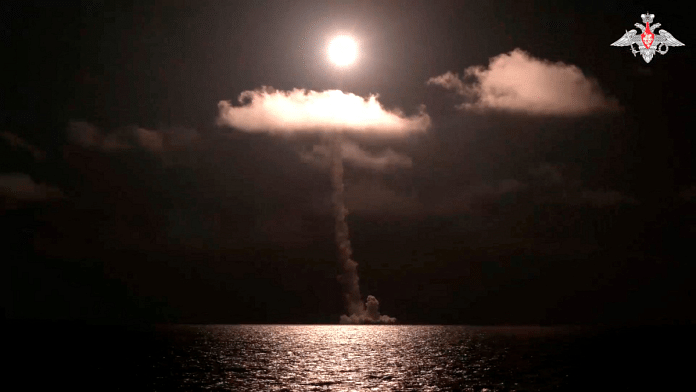New Delhi: Amid the tensions between the US and Russia over Ukraine, Moscow Sunday successfully test-fired its Bulava intercontinental ballistic missile from its new nuclear submarine — The Imperator Alexander III.
The Imperator Alexander III is the seventh of the Russian Project 955 Borei-class nuclear submarines and the fourth of the modernised Project 955A Borei-A variant.
Project 955 and 955A submarines have been developed by the Rubin Central Design Bureau for Marine Engineering, which is also helping India in its submarine programme.
Compared to its predecessors, the upgraded Borei-A submarine features a modernised hull and new electronics, besides having better stealth features.
Meanwhile, the Borei-class submarine, which carries the NATO reporting name Dolgoruky-class, named after the first of the class, is 170 metres long and is estimated to travel up to 29 knots once submerged. These submarines carry 16 Bulava missiles with six MIRVs (Multiple Independently Targetable Re-entry Vehicle), which are 12 metres long and have a range of up to 8,000 km.
Analytical research done on Russian submarines by Nuclear Threat Initiative (NTI), a non-profit global security organisation focused on reducing nuclear and biological threats, states that with pump-jet propulsion and other acoustic improvements, the Borei-class submarines stand out in stealth capabilities compared to their predecessors.
According to reports, Russia plans to build nearly 14 Borei-class submarines, which will then be divided between its Northern and Pacific fleets. It aims to use these submarines as the core naval component of the nation’s nuclear forces in the coming decades.
Russia is estimated to have a total of 58 submarines, of which 11 are ballistic missile submarines, 17 are nuclear-powered attack submarines, nine are nuclear-powered cruise missile submarines and 21 are diesel-electric attack submarines.
Apart from the Borei-class submarine variants, Russia operates Delfin-class, Kalmar-class, Antey-class, Shchuka B-class, Project 945 and Project 945A, Shchuka-class, Yassen-class, Project 877/636 Varshavyanka and Lada-class submarines, according to NTI.
Also Read:55 aboard China’s nuclear submarine dead, ‘caught in trap for US, allied’ ships, says UK daily
Borei-class submarines set to replace old ones
First launched in 1996, the Borei-class nuclear submarines were instrumental to Russia’s post-Cold War strategic arsenal. This class is set to replace the ageing Kalmar-class and Delfin-class submarines.
It was in 2017 that Russia first launched its Borei-A class submarine, known as ‘Knyaz Vladimir,’ a significantly upgraded version of the original design, which became fully operational four years later.
Speaking about the Borei-class submarines to the Russian media in 2018, Alexander Blagov, director of the Kurchatov Institute R&D Centre, said Russia’s Borei strategic missile submarines are “doubly quiet than the US Virginia class.”
“Enormous work was done to lower the noise level of submarines and reduce physical fields. The noise level of the Borei strategic underwater missile-carrying cruiser is five times lower than that of the third-generation Shchuka-B multipurpose nuclear-powered sub and two times lower than the US Virginia class,” Russian news agency Tass quoted Blagov as saying.
Latest addition: Borei-K class submarines
In April 2019, the Russian Ministry of Defence announced the building of two new Borei-K-class nuclear submarines, which is the latest class of submarines operated by the Russian Navy.
The first of these ships, the Knyaz Oleg, was laid down in July 2014 and was commissioned to the Pacific fleet in late 2021. The Generalissimo Suvorov, the second ship of this class, was commissioned for service in late 2022. These are said to be operating in Russia’s Northern fleet.
The Borei-K class of vessels are identical to the earlier Borei-class submarines, however, one of the major differences is that they are capable of firing long-range cruise missiles instead of Submarine-Launched Ballistic Missiles (SLBM).
The Borei-K class submarines are equipped with a hydrodynamic hull that provides an acoustic signature — which describes a combination of acoustic emissions of sound emitters in ships and submarines.
(Edited by Richa Mishra)
Also Read: Australia, US & UK strike ‘$245 billion’ submarine deal to counter China



